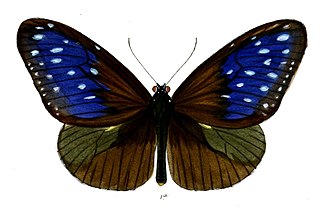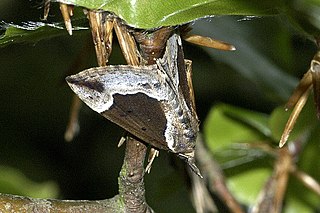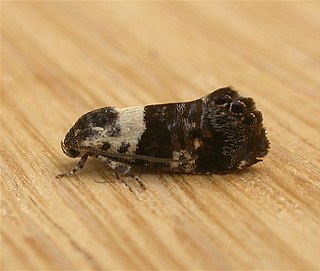
Euploea mulciber, the striped blue crow, is a butterfly found in India and Southeast Asia that belongs to the crows and tigers, that is, the danaid group of the brush-footed butterflies family.

Jamides bochus, the dark cerulean, is a small butterfly found in Indomalayan realm that belongs to the lycaenids or blues family. The species was first described by Caspar Stoll in 1782.

Hypena crassalis, the beautiful snout, is a moth of the family Erebidae. The species was first described by Johan Christian Fabricius in 1787. It is found in Europe.

Cucullia chamomillae, the chamomile shark, is a moth of the family Noctuidae. The species was first described by Michael Denis and Ignaz Schiffermüller in 1775. It is found in Central Europe, Southern Europe, the Near East and North Africa.

Ypsolopha scabrella, the wainscot hooktip or wainscot smudge, is a moth of the family Ypsolophidae. The species was first described by Carl Linnaeus in 1761. It is found in Europe, China, Russia, Asia Minor and mideast Asia.

Eupselia aristonica is a species of moth of the family Depressariidae. It is found in Australia, where it has been recorded from New South Wales, the Australian Capital Territory, Victoria and Tasmania.

Mesapamea secalis, the common rustic, is a moth of the family Noctuidae. The species was first described by Carl Linnaeus in his 1758 10th edition of Systema Naturae. It is found in Europe, north-west Africa, Turkey and northern Iran.

Mythimna decisissima is a moth of the family Noctuidae first described by Francis Walker in 1856. It is found from India across south-east Asia including Hong Kong, Japan, Taiwan and Australia in Queensland and New South Wales. It is also present in South Africa.

Adela croesella is a moth of the family Adelidae. It is found in most of Europe.
Batrachedra trimeris is a species of moth of the family Batrachedridae. It is found in Australia.
Tebenna immutabilis is a moth of the family Choreutidae. It is known from the United States, including California.

Heterocrossa gonosemana is a species of moth in the family Carposinidae. It is endemic to New Zealand.
Cosmopterix macroglossa is a moth in the family Cosmopterigidae. It was described by Edward Meyrick in 1913. It is found in South Africa.
Arogalea senecta is a moth of the family Gelechiidae. It is found in Mexico (Guerrero).
Filatima isocrossa is a moth of the family Gelechiidae. It is found in North America, where it has been recorded from Texas.
Gnorimoschema coquillettella is a moth in the family Gelechiidae. It was described by August Busck in 1902. It is found in North America, where it has been recorded from California and Colorado.
Gnorimoschema ericameriae is a moth in the family Gelechiidae. It was described by Keifer in 1933. It is found in North America, where it has been recorded from California.
Lecithocera telosperma is a moth in the family Lecithoceridae. It was described by Alexey Diakonoff in 1968. It is found on Luzon in the Philippines.
Eupselia theorella is a moth in the family Depressariidae. It was described by Edward Meyrick in 1880. It is found in Australia, where it has been recorded from New South Wales.
Antaeotricha camarina is a moth in the family Depressariidae. It was described by Edward Meyrick in 1915. It is found in Guyana.









